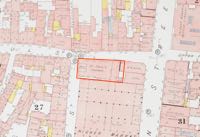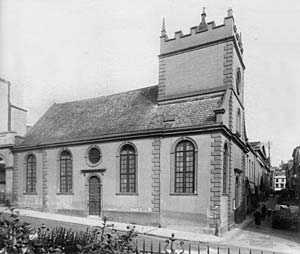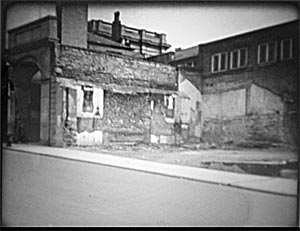
St Paul's Church, Paul Street
Page added 5th May 2016
 Paul Street which is known by most as the place to go to park your car was once a
thriving community inside the northern line of the city wall. There
were
once hundreds of small tenements jammed between the street and
the city wall with courts and alleys such as Maddocks Row, Cornish
Court and Arthur's Place. The population had their own church, St
Paul's to attend to their spiritual needs.
Paul Street which is known by most as the place to go to park your car was once a
thriving community inside the northern line of the city wall. There
were
once hundreds of small tenements jammed between the street and
the city wall with courts and alleys such as Maddocks Row, Cornish
Court and Arthur's Place. The population had their own church, St
Paul's to attend to their spiritual needs.
The parish of St Paul (Pol de Leon) may have been of Celtic foundation, sitting as it does, near the old British quarter of the city. It is known that in 1285, it was joined with the parish of St Cuthbert due to the impoverished state of the two. St Cuthbert's church was just inside the North Gate, the opposite twin to that of Holy Trinity inside the South Gate.
After the Civil War, during the short lived Commonwealth of Cromwell the church was closed and the building given to the elders of the city as a Grammar School but the citizens claimed it back after a short time. The church was rebuilt in 1680 as a simple rectangular stone building in an Italianate style with a nave and west tower with pinnacles, containing a single bell cast by one John Wroth of Exeter.
The church contained an oval font of black marble and the east window was of stained glass depicting a full length figure of St Paul. In 1879 the church was restored internally at a cost of £664 and the capacity set at 250 persons. The church register dates go back to 1562.
Notable burials
Sir Edward Seaward, Mayor in 1691 was buried in St Paul's churchyard in 1703. He is remembered for his work as governor at the old hospital and workhouse, and as the principal benefactor of Berry (Bury) Meadow. John Patch, who built Rougemont House, and was a physician at the early Devon and Exeter Hospital, was also buried in the church. In 1854, a Royal Order of Coincil was approved to discontinue burials in the church and small church yard.
Electric light, along with a screen and choir stalls were installed in June 1912. In the early 1930s an inspection was made of the belfry, and ten old fire buckets belonging to the Sun Insurance Company were found–they had been installed at the beginning of the eighteenth century as a precaution against fire. As early as 1931, consideration was being given to demolish St Paul's, as part of a scheme to redevelop the area.
Demolished
In June 1936, the church of St Paul was demolished–some of the memorials were relocated to St Martin's in the Close. A condition at the time was that the tower was to be retained, but in the event, it too went. The site was sold to the council, for their scheme to build a new Civic Hall on the Higher Market site, a scheme that never happened. The funds from the sale were used for building a new church in the suburbs.
During the war a British Restaurant was installed on the site. By the 1960s the building opened as a club for young people called The Look in, which was the venue for gigs by the Empty Vessels, who evolved into Wishbone Ash.
There is also a St Paul's Church in Burnthouse Lane.
Source: Kellys 1897, Two Thousand Years in Exeter by Hoskins, Exeter Past by Hazel Harvey, local newspapers including the Western Times, and Express and Echo.
 St Paul's Church on the corner of Paul
and Goldsmith Street. There is an intriguing view of the rear of the
Higher Market down Goldsmith Street on the right.
St Paul's Church on the corner of Paul
and Goldsmith Street. There is an intriguing view of the rear of the
Higher Market down Goldsmith Street on the right.
 The
empty site of St Paul's Church shortly after it was demolished - still
from the Garton and King film.
The
empty site of St Paul's Church shortly after it was demolished - still
from the Garton and King film.
│ Top of Page │